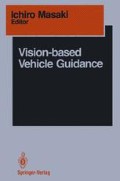Abstract
This article describes the work at INRIA on obstacle avoidance and trajectory planning for a mobile robot using stereo vision. Our mobile robot is equipped with a trinocular vision system that is being put into hardware and will be capable of delivering 3-D maps of the environment at rates between 1 and 5 Hz. The 3-D maps contain line segments extracted from the images and reconstructed in three dimensions. They are used for a variety of tasks, including obstacle avoidance and trajectory planning.
For those two tasks, we project on the ground floor the 3-D line segments to obtain a two-dimensional map, simplify the map according to some simple geometric criteria, and use the remaining 2-D segments to construct a tessellation, more precisely a triangulation, of the ground floor. This tessellation has several advantages.
It is adapted to the structure of the environment since all stereo segments are edges of triangles in the tessellation.
It can be efficiently computed (the algorithm we use has a complexity o(n) if n is the number of segments used).
It is dynamic in the sense that segments can be efficiently added or subtracted from an existing triangulation.
We use this triangulation as a support for further processing. We first determine free space simply by marking those triangles that are empty, again a very simple process, and then use the graph formed by those triangles to generate collision-free trajectories. When new sensory data are acquired, the ground floor map is easily updated using the nice computational properties of the Delaunay triangulation, and the process is iterated.
We show an example in which our robot navigates freely in a real indoor environment using this system.
Access this chapter
Tax calculation will be finalised at checkout
Purchases are for personal use only
Preview
Unable to display preview. Download preview PDF.
References
Ayache, Nicholas, and Faugeras, Olivier D. (1989). “Maintaining Representations of the Environment of a Mobile Robot.” IEEE Transactions on Robotics and Automation, December. Also INRIA Report 789.
Ayache, N., and Lustman, F. (1987). “Fast and Reliable Passive Trinocular Stereovision. In Proceedings ICCV’87, London, 422–427, IEEE, June.
Faugeras, Olivier D., Lebras-Mehlman, Elizabeth, and Boissonnat, Jean-Daniel. (1990). Representing Stereo data with the Delaunay Triangulation. Artificial Intelligence Journal 44(1–2), July (also INRIA Tech. Report 788).
Preparata, F., and M. Shamos, (1985). Computational Geometry. Springer-Verlag, Berlin and New-York.
Zhang, Zhengyou, and Faugeras, Olivier D. (1990). “Building a 3D World Model with a Mobile Robot: 3D Line Segment Representation and Integration.” In Proceedings of the 10th International Conference on Pattern Recognition, 38–42, IEEE Computer Society, June.
Zhang, Zhengyou, and Faugeras, Olivier D. (1990). “Motion Analysis of Two Stereo Views and Its Applications. In Proceedings of the ISPRS Symposium on Close-Range Photogrammetry Meets Machine Vision, September.
Zhang, Zhengyou, and Faugeras, Olivier D. (1990). “Tracking and Motion Estimation in a Sequence of Stereo Frames.” In Proceedings of the 9th European Conference on Artificial Intelligence, ECAI, August 1990.
Zhang, Z., Faugeras, O. D., and Ayache, N. (1988). “Analysis of a Sequence of Stereo Scenes Containing Multiple Moving Objects Using Rigidity Constraints.” In Proc. the Second International Conference on Computer Vision, 177–186, IEEE, Tampa, Florida, December.
Zhang, Zhengyou (1990).”Analysis from a Sequence of Stereo Frames and Its Applications.” PhD Thesis, University of Paris-Sud, Orsay, Paris, France, (in English).
Editor information
Editors and Affiliations
Rights and permissions
Copyright information
© 1992 Springer-Verlag New York, Inc.
About this chapter
Cite this chapter
Buffa, M., Faugeras, O.D., Zhang, Z. (1992). Obstacle Avoidance and Trajectory Planning for an Indoor Mobile Robot Using Stereo Vision and Delaunay Triangulation. In: Masaki, I. (eds) Vision-based Vehicle Guidance. Springer Series in Perception Engineering. Springer, New York, NY. https://doi.org/10.1007/978-1-4612-2778-6_13
Download citation
DOI: https://doi.org/10.1007/978-1-4612-2778-6_13
Publisher Name: Springer, New York, NY
Print ISBN: 978-1-4612-7665-4
Online ISBN: 978-1-4612-2778-6
eBook Packages: Springer Book Archive

